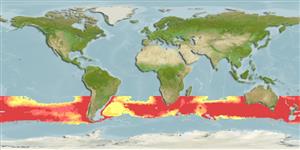Actinopterygii (ray-finned fishes) >
Stomiiformes (Lightfishes and dragonfishes) >
Stomiidae (Barbeled dragonfishes) > Idiacanthinae
Etymology: Idiacanthus: Greek, idia = own privative + Greek, akantha = thorn (Ref. 45335).
Environment / Climate / Range
Ecology
Marine; bathypelagic; depth range 1239 - 2000 m (Ref. 58018). Deep-water, preferred ?; 25°S - 60°S
Subtropical to temperate waters in the southern hemisphere, probably limited by the subtropical convergence. Incidentally found in sub-Antarctic waters of the Southern Ocean.
Size / Weight / Age
Maturity: Lm ? range ? - ? cm
Max length : 53.0 cm SL male/unsexed; (Ref. 7249)
Short description
Morphology | Morphometrics
Mesopelagic species (Ref. 75154). Pronounced sexual dimorphism: females are black, with well developed canine teeth, barbel and pelvic fins with six stripes. Males are dark-brown, have no teeth on maxilla and neither barbel nor pelvic fins (Ref. 47377). Apparently, females live below 500 m during the day and perform vertical migration at night to shallower depths; males always in deep water, ca 1,000-2,000 m (Ref. 5169).
Life cycle and mating behavior
Maturity | Reproduction | Spawning | Eggs | Fecundity | Larvae
Krueger, W.H., 1990. Idiacanthidae. p. 341-342. In J.C. Quero, J.C. Hureau, C. Karrer, A. Post and L. Saldanha (eds.) Check-list of the fishes of the eastern tropical Atlantic (CLOFETA). JNICT, Lisbon; SEI, Paris; and UNESCO, Paris. Vol. 1. (Ref. 7249)
IUCN Red List Status (Ref. 115185)
CITES (Ref. 94142)
Not Evaluated
Threat to humans
Harmless
Human uses
Fisheries: of no interest
More information
Age/SizeGrowthLength-weightLength-lengthLength-frequenciesMorphometricsMorphologyLarvaeLarval dynamicsRecruitmentAbundance
ReferencesAquacultureAquaculture profileStrainsGeneticsAllele frequenciesHeritabilityDiseasesProcessingMass conversion
Tools
Special reports
Download XML
Internet sources
